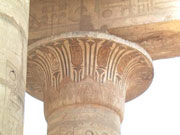TOUR NEWS - SPAIN MAY 2013
Our inaugural tour of Ancient and Moorish Spain ran from 5th to 27th May 2013. We had a keen group of history buffs including: Margaret Debenham, Karen Hoare, Virginia Stone, Veronica McKervey, Boris Sokoloff, Anna Johnson, Jon Dalrymple, Robyn Luhrs, Sandy Bardsley, Margaret Gaydon, Margaret Larkin, Catherine Clarke, Barbara Cummins, Joanna Quinn, Francois Devos and Robyn Butler. The tour was led by the author, Michael Birrell.
 |
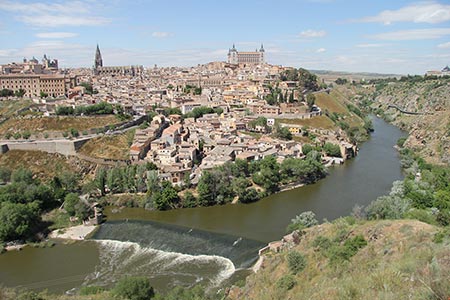 |
The walls of Avila |
The view of Toledo |
I arrived in Madrid a few days early, which gave me a chance to see a few new things. I enjoyed a wander round the old quarter of the city. I met up with Robyn and Francois and went by bus to see the impressive palace complex of Philip II at El Escorial north of Madrid. It is colossal, monolithic and as cold as a grave, appropriate as the kings lived above the bodies of their dead ancestors!
I met the group on the morning of the 6th May and we checked into the Europa Hotel in the centre of the town. We went for a walk in the old quarter where we saw the old Muslim walls of Madrid, the outside of the Royal palace and the Temple of Dabob, a gift to Spain during the building of the Aswan Dam. The following morning we went by train to the Prado Museum which houses a stunning collection of European art. We concentrated on the Spanish artists such as Velasquez, el Greco and Goya. In the afternoon, after having some lunch at the Prado, we went to the Royal Palace. It is a stunning building with very grand dining hall and throne room.
We then left Madrid by bus, heading north through scenic country to the medieaval town of Segovia - there was still some snow on the surrounding hills. We had a much needed hot chocolate and churros (Spanish donut) in the shadow of the 2nd Century AD Roman aqueduct, a stunning work of Roman engineering. We then walked into town past numerous medieval villas and stopped to see wonderful examples of Romanesque architecture. We explored the city walls and gates, and had a look at the excellent little town museum before entering the stunning Alcazar, a 14th Century castle used as a model for the Disney castle. In the afternoon we headed the short distance to Avila where we checked into our hotel which incorporated an old villa. We went for a walk round the illuminated walls of this wonderful heritage city and tried some of the local cuisine in a converted mansion.
In the morning the sun came out - we walked along the walls and went to the Church of St Vincent which contains a fantastic Gothic grave. We also saw the monastic centre where St Teresa lived - there is nothing like Catholic marketing! In the afternoon we stopped off to see the Monastery of Santo Tomas where Juan, the son of Isabella and Ferdinand, is buried. Our road then took us through the mountains down to Toledo where we checked into our hotel. This was the old Bishop�s Palace built into the walls of the old quarter. We walked down to the stunning medieval St Martin Bridge across the Tagus River.
 |
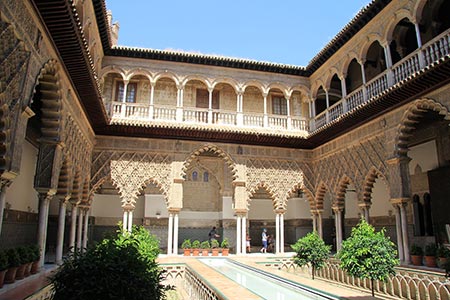 |
The Roman theatre at Merida |
The stunning Royal palace in Seville |
The following day, the 10th May, we explored the historic quarter of Toledo which preserves many monuments from the 10th Century onwards. A highlight was the stunning Gothic Cathedral from the 13th Century and the Mudejar Church of San Roman which houses an interesting collection of Visigothic material. We also saw two synagogues and the beautiful Isabelline Monastery of St John (Margaret Gaydon had fond memories of the place as the 15th Century chapel was where her son had married). Our trip then took us SW of Toledo through rich countryside. We made an unscheduled stop at Trujillo to see the mediaeval quarter of the town where the conquistador Francisco Pizarro was born. This terrible man, who conquered the Incas in Peru, is commemorated by an equestrian statue in the main square. We then headed to Merida and checked into our hotel (a converted monastery). Merida is a well preserved ancient Roman settlement. We walked through the arches of the stunning aqueduct and down to the bridge across the Guadiana River. The theatre and amphitheatre form a spectacular complex on the edge of the ancient city, and not far away we saw the well preserved hippodrome. The Museum of Roman Antiquities is excellent and has a wide range of artefacts and mosaics. Our road then took us south to the Roman site of Italica - it has a wonderful amphitheatre and the houses preserve numerous mosaics in situ.
Seville is a wonderful place to spend a few days. The old quarter is relatively small and it was possible for us to walk everywhere. We went to see the Gothic Cathedral from the 15th Century and climbed up the Giralda Tower, in reality a minaret from Almohad Period when this was the site of the Great Mosque. We also had some free time - some of us explored a number of private villas which are open to the public. The 'parasol' (a massive wooden sculptural building) over the Roman ruins is also fascinating. In the evening we went to see a touristy version of the flamenco and walked round the illuminated Cathedral.
On the 14th May we walked through town to the stunning Plaza de Espana, a pavilion built for the Spanish American Fair in the 1920 (but better known to some of us as Queen Amidala's Palace in Star Wars Episode II). We walked through the beautiful park of Maria Luisa and visited the Archaeological Museum which has a very good collection of Roman artefacts. In the afternoon we visited the Alcazares Reales, the Mudejar (Muslim style) palace of King Pedro II - it contains magnificent Islamic rooms. A free day in Seville was easily spent wandering through the old quarter and visiting art galleries.
The next day we left Seville and headed down the Guadalquivir River to Cadiz on the Atlantic Coast. We went to the Archaeological Museum of Cadiz which has a fascinating collection of Phoenician artefacts including two magnificent limestone sarcophagi. We also went for a walk through the old city and visited the crumbling Baroque cathedral near the seaside. In the morning we headed east along the coast to Baelo Claudia, a spectacular Roman ruin which preserves a theatre, forum, basilica and town walls. We had a very clear view across the Straits of Gibraltar towards Morocco. Our road then took us along to the coast where we stopped to see the famous Rock of Gibraltar before heading up into the hills to Ronda. It was stormy and wet for our journey and we saw a wonderful rainbow across the spectacular gorge of Ronda while having a very pleasant dinner.
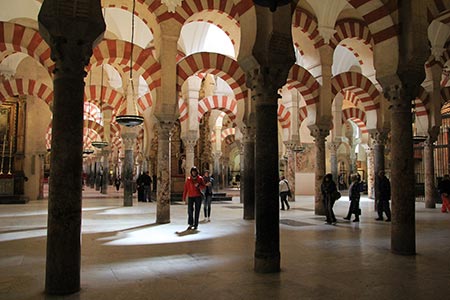 |
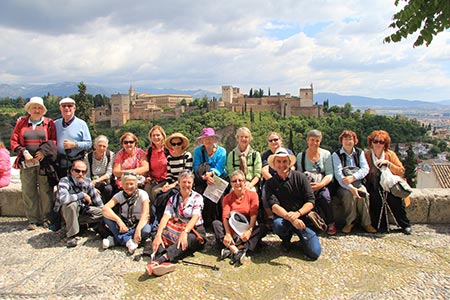 |
The Great Mosque of Cordoba |
The group in front of the Alhambra |
On the 18th of May we explored the many wonderful sights of Ronda. This is one of the famous hill towns of Andalusia and preserves a number of Moorish buildings, most famously the Arab Baths which we reached through a country path amongst beautiful spring flowers. The magnificent 18th Century Bridge across the Tajo Gorge is mesmerising. I also enjoy visiting the Museum in the Mondragon House which has a good collection of artefacts from the local area. The following day we continued our journey, stopping in the mediaeval town of Antequera to see the fantastic megalithic dolmen tombs, built in the 3rd Millennium BC. We arrived in Cordoba in the afternoon and went for a walk around the Great Mosque. Built in the 8th Century it dominates the old quarter - our hotel was directly next to the mosque.
We spent two nights in Cordoba. During that time we explored the stunning Great Mosque (which is so huge that it contains a 16th Century Baroque Cathedral deep within it), went to the Alcazar Gardens and walked over the Roman Bridge to see the Tower of Calahorra which has an audio tour explaining the interaction of Muslim and Christian culture in the city. Cordoba has a rich history and some free time was spent exploring the old quarter and hunting out the ruins of the Roman Temple.
On the 21st May we left Cordoba and headed across the Guadalquivir River to the ruins of Medinet az-Zahara, a splendid royal residence built by Sultan Abd el-Rahman III in the 10th Century as the centre of his Empire. The ruins give a wonderful impression of life at the time - restoration works are ongoing and under the current financial circumstances might be left incomplete for some time. From here we headed south again, passing through broad fields until we reached Granada.
We had a walk through the old quarter of Granada exploring some of the historic buildings including the Arab Baths and the Cathedral with its impressive Gothic chapel containing the burials of Isabella and Ferdinand. We also ascended the Albaicin Hill for a stunning view across to the Alhambra Palace. The following day we went to the Alhambra. We explored this impressive collection of royal buildings, including the Red Fort, the palace of Charles V and the Generalife gardens. Our visit to the Nasrid palaces was in the early evening - it was cool and relatively quiet and after a recent restoration they have re-opened the Court of the Lions.
 |
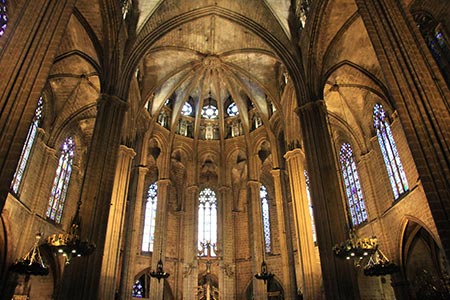 |
The Court of the Lions in the Alhambra |
Santa Maria del Mar in Barcelona |
The following morning we packed up early and met our bus for the trip down to Malaga Airport. We had a short flight to Barcelona, our final stop on the trip. We checked into our hotel in the historic quarter and went for a walk to see the Gothic Cathedral. We also saw the Roman ruins located underneath the palace of the Kings of Aragon. On our final day (the 25th May) we explored the stunning Sagrada Familia, the not yet completed basilica designed by Antoni Gaudi. It leaves an impression of walking in an enormous forest. The last afternoon was free time for the group � some went to see the Picasso collection, while others went to see the remarkable Gaudi villas and Park Guell.
Michael Birrell
